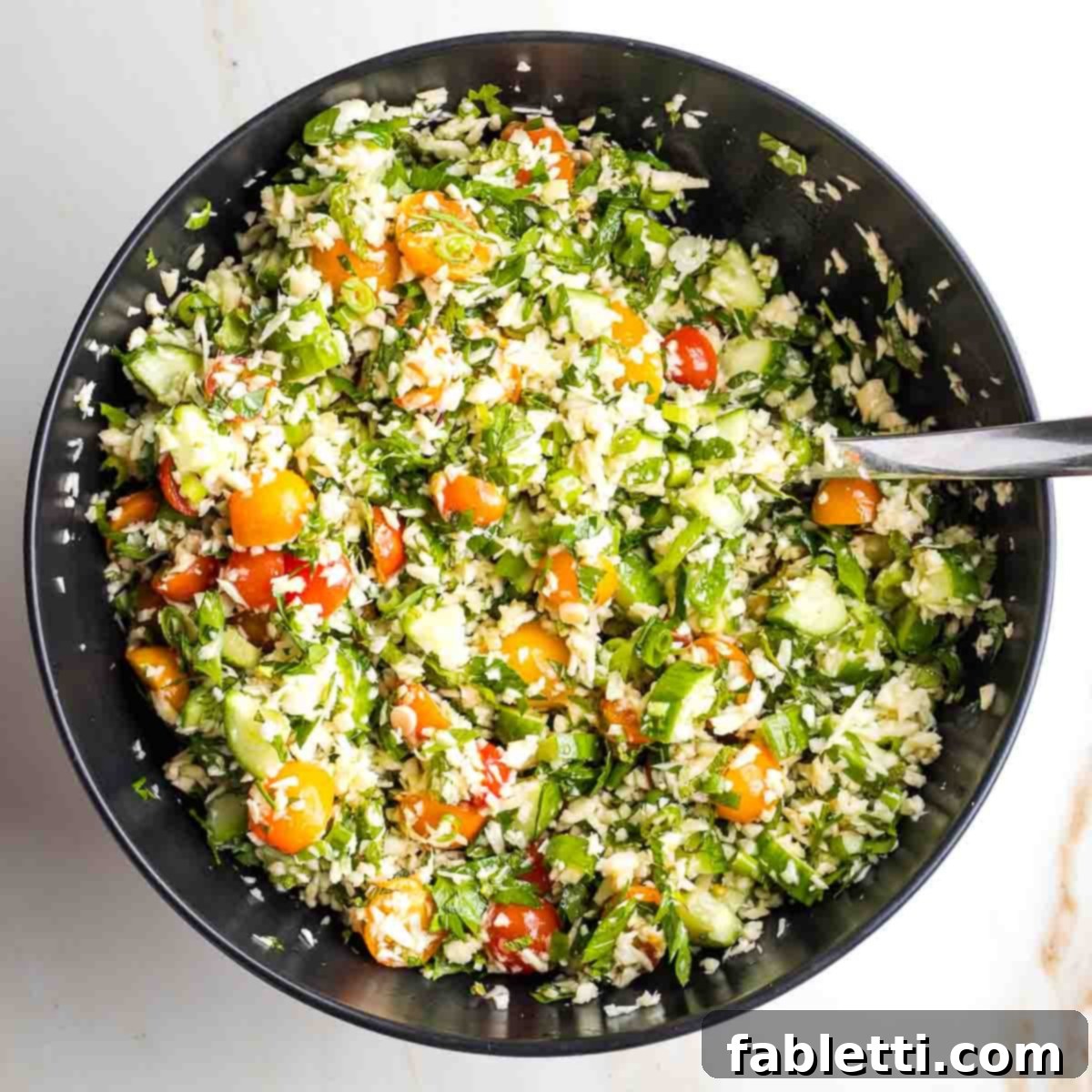Discover a vibrant and incredibly satisfying salad that reimagines a beloved Middle Eastern classic: Gluten-Free Tabbouleh with Parsnips. This innovative recipe replaces traditional bulgur wheat with finely riced parsnips, offering a unique, naturally sweet, and earthy flavor profile that’s both light and remarkably fulfilling. Packed with the freshest ingredients like juicy tomatoes, crisp cucumbers, fragrant fresh herbs, and bright green onions, this salad elevates the humble side dish to a culinary masterpiece. It’s a delightful exploration of Mediterranean flavors, perfectly suited for anyone seeking a wholesome, gluten-free, and deliciously refreshing meal.
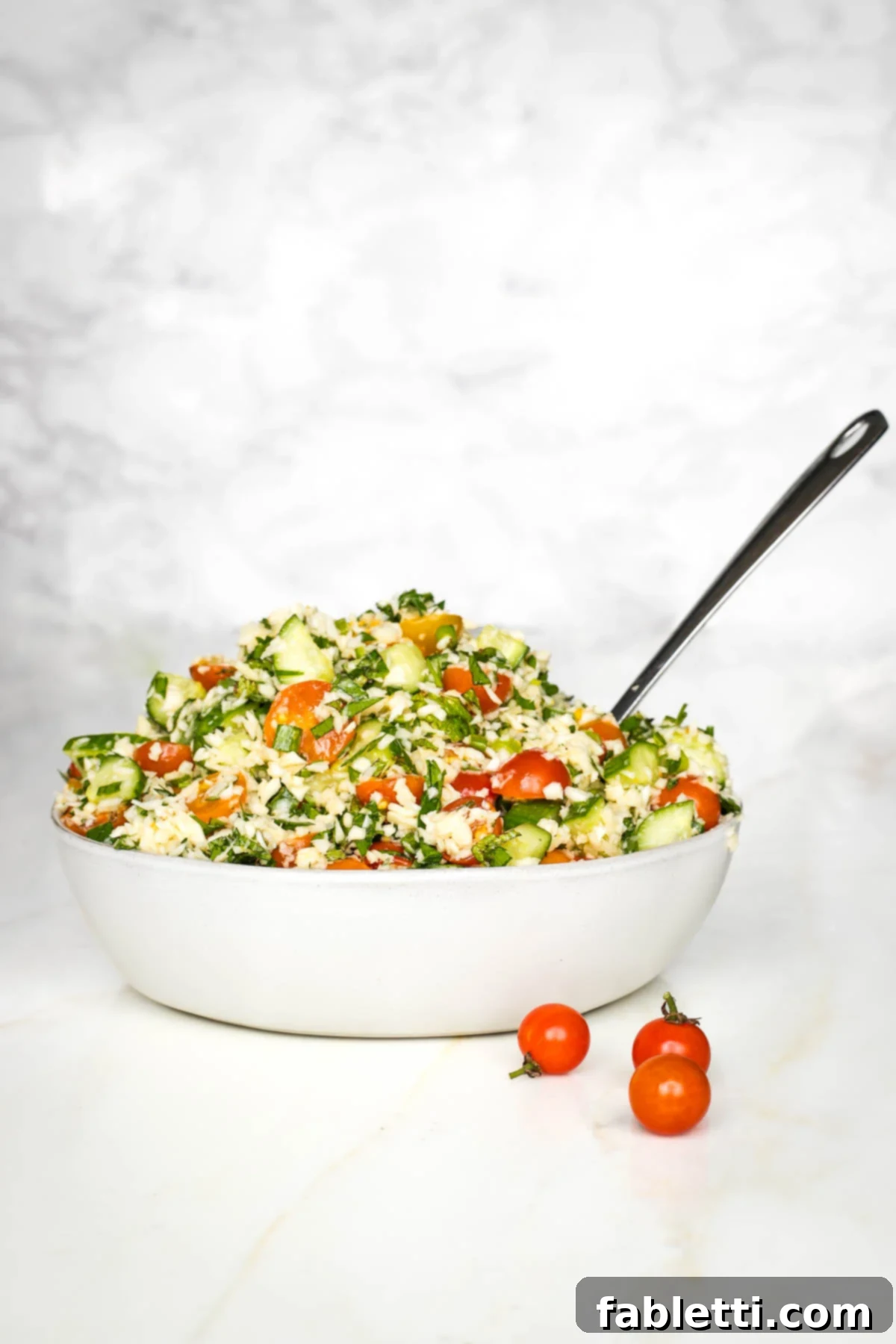
This post has been updated from the original published on April 27, 2016, to bring you even more tips and deliciousness.
A Modern Twist on Tabbouleh: The Parsnip Revolution
Traditional tabbouleh is celebrated for its fresh flavors and use of bulgur wheat. However, for those on gluten-free or grain-free diets, finding an authentic substitute that doesn’t compromise on taste or texture can be a challenge. Enter the humble parsnip – a root vegetable often overlooked, but here, it steps into the spotlight as our secret ingredient. When riced, parsnips perfectly mimic the texture of bulgur, providing that essential chewiness and bulk without any gluten. Beyond its textural prowess, parsnips infuse the salad with a subtle nutty sweetness and a wealth of added nutrition, making this dish not just a substitute, but an upgrade. Get ready to experience tabbouleh like never before, bursting with freshness and wholesome goodness!
Why You’ll Adore This Gluten-Free Parsnip Tabbouleh
- Unmatched Freshness: The combination of ripe tomatoes and an abundance of fresh herbs creates an explosion of clean, vibrant flavors that dance on your palate. It’s truly a winning combination!
- Effortlessly Simple: Forget complicated dressings! This recipe relies on the natural brightness of freshly squeezed lemon juice and the richness of quality olive oil. It’s quick to assemble, making it perfect for busy weeknights or impromptu gatherings.
- Fantastic for Meal Prep: This salad actually tastes even better the next day! The flavors meld and deepen overnight, allowing for a more harmonious and intense taste experience. It’s an ideal make-ahead dish.
- Healthy & Versatile: Serve it as a refreshing side dish alongside your favorite main course, or transform it into a complete plant-based meal by adding chickpeas, lentils, or nuts for extra protein and fiber.
- Nutrient-Dense: Crafted with a bounty of fresh vegetables and the added goodness of parsnips, this salad is loaded with essential vitamins, minerals, and antioxidants, supporting a healthy lifestyle.
- Dietary Friendly: Naturally gluten-free, grain-free, and vegan, this tabbouleh caters to a wide range of dietary needs without sacrificing an ounce of flavor.
Exploring more Healthy Passover Recipes? Uncover inspiring and delicious ways to enjoy Kosher for Passover dishes while maintaining a balanced diet with Vegetarian and Vegan Recipes for Passover.
Essential Ingredients for Your Perfect Tabbouleh
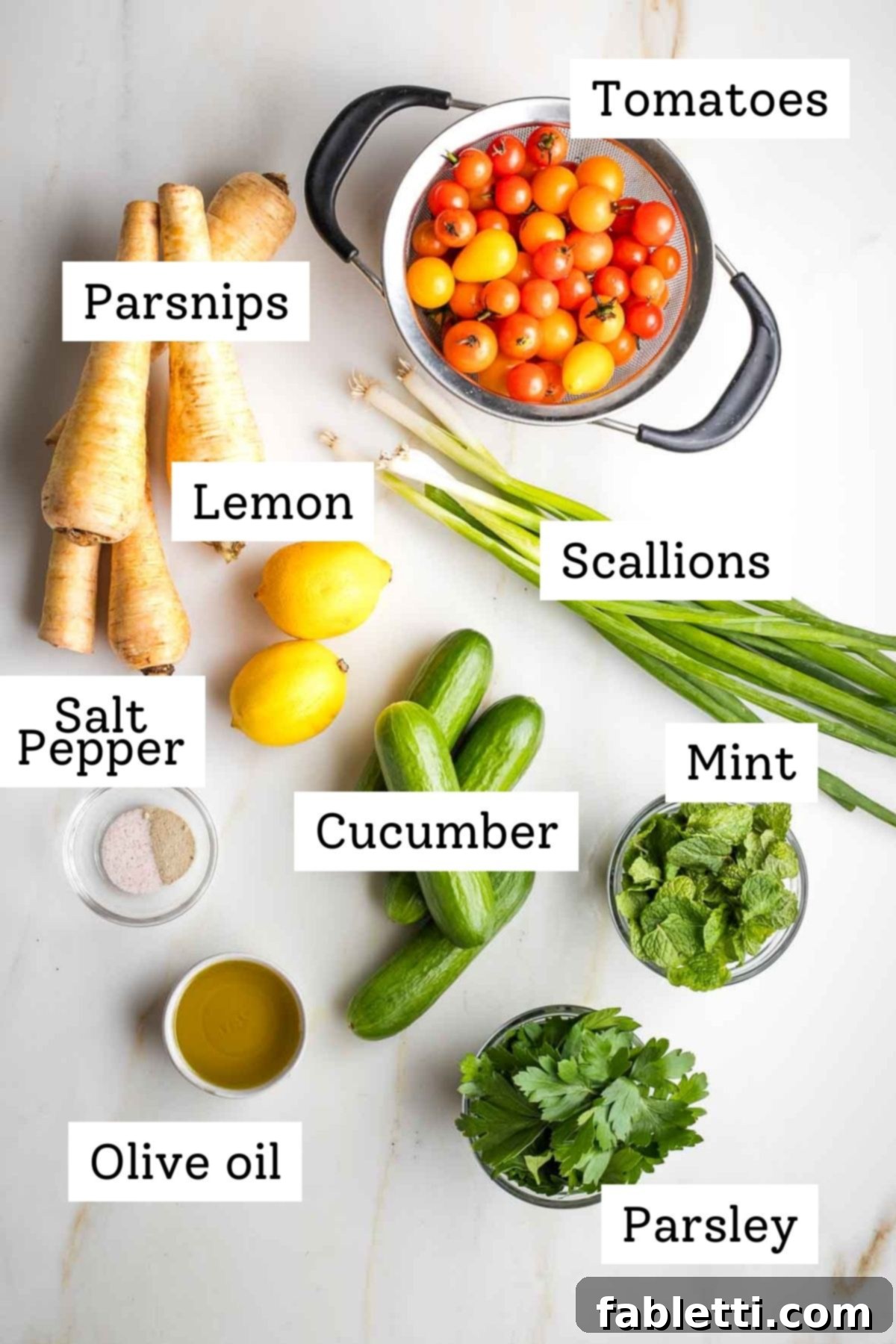
- Parsnips: The star of our gluten-free show! Parsnips bring a delightful, slightly nutty, and sweet flavor. They are incredibly easy to pulse into grain-like pieces using a food processor. If parsnips aren’t available or you prefer an alternative, cauliflower rice or cooked quinoa (ensure it’s cooled) are excellent gluten-free substitutes that maintain the desired texture and nutrition.
- Tomatoes: For the best results and visual appeal, small, ripe tomatoes are ideal. Think cherry, grape, or pear tomatoes in a mix of vibrant colors. Their natural sweetness and firm texture hold up beautifully in the salad. If using larger tomatoes, simply chop them into bite-sized pieces.
- Scallions (Green Onions): These provide a mild, fresh onion flavor without overpowering the delicate herbs. Both the white and green parts are used. You can also use spring onions or, for a sharper kick, thinly sliced red onion.
- Cucumber: Choose firm, crisp cucumbers for that satisfying crunch. Small Persian cucumbers are fantastic, as are English cucumbers, which have fewer seeds and thinner skins. Avoid varieties that are too watery or soft.
- Fresh Parsley: This is the backbone of tabbouleh’s signature fresh taste. While curly parsley is traditionally seen, flat-leaf (Italian) parsley offers a more robust flavor and a slightly smoother texture, which I personally prefer. Don’t skimp on the parsley – it’s crucial for authenticity and flavor!
- Fresh Mint: A vital component for that distinct Mediterranean zest. Fresh mint leaves burst with an invigorating, cooling flavor that perfectly complements the other ingredients. Use only fresh leaves, as dried mint won’t provide the same impact.
- Lemon: Fresh lemon is key for balancing the flavors and adding a bright, zesty note. For the most intense flavor, use both the zest and the juice. The zest contains essential oils that elevate the overall aroma.
- Extra Virgin Olive Oil: A cornerstone of Mediterranean cuisine, extra virgin olive oil not only binds the salad together with a rich, fruity flavor but also plays a crucial role in nutrition. Its healthy fats aid in the absorption of fat-soluble vitamins found in the fresh vegetables and herbs, making your salad even more beneficial.
- Salt and Pepper: Simple seasonings that enhance all the natural flavors. Adjust to your taste preferences.
The Nutritional Powerhouse: Parsnips
Parsnips are far more than just a root vegetable; they are a nutritional goldmine. Rich in essential vitamins like Vitamin C, they bolster your immune system and act as a powerful antioxidant. They are also an excellent source of potassium, crucial for maintaining healthy blood pressure and fluid balance. Furthermore, parsnips are packed with dietary fiber, which not only aids digestion and promotes gut health but also helps to stabilize blood sugar levels, despite their slightly higher carbohydrate content compared to some other vegetables. Their anti-inflammatory properties further contribute to overall wellness, making them a fantastic addition to any healthy diet. Don’t let their carbohydrate profile deter you; parsnips are low in calories and incredibly beneficial!
- Honey Roasted Carrots and Parsnips
- Dairy-free Garlic Mashed Potatoes
- Parsnip and Kale Soup
- Homemade Vegetable Broth Recipe
Crafting Your Gluten-Free Tabbouleh Masterpiece: A Step-by-Step Guide
Creating this refreshing parsnip tabbouleh is surprisingly straightforward, requiring just a few kitchen essentials. A sharp chef’s knife and a sturdy wooden cutting board will make quick work of transforming fresh vegetables into the foundation of this healthy salad. The key to our grain-free twist lies in using a food processor to ‘rice’ the parsnips, achieving that perfect bulgur-like texture. If you don’t own a food processor, don’t worry! You can easily find pre-riced cauliflower in the produce section or frozen aisle of most grocery stores, providing a convenient alternative.
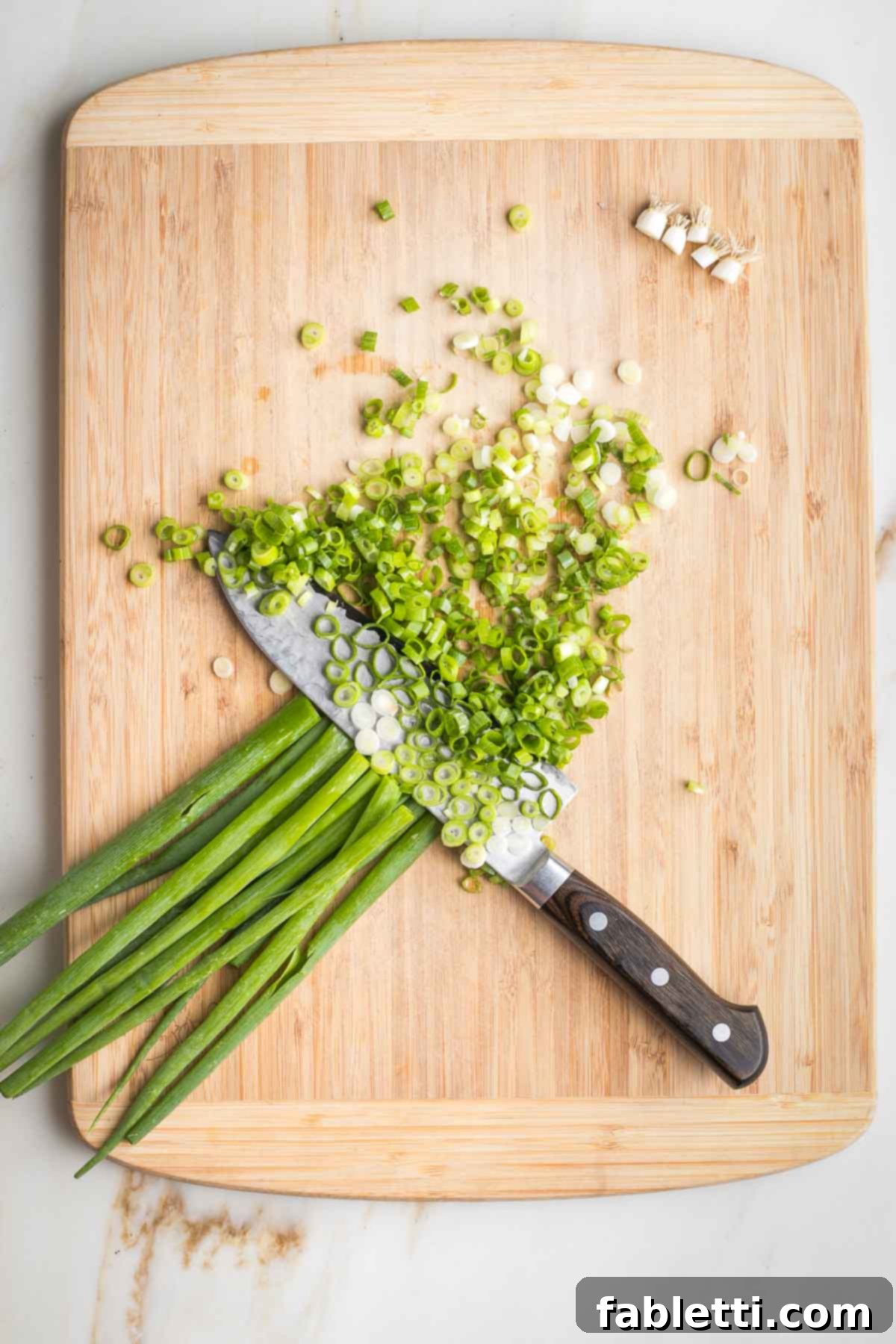
Begin by thoroughly cleaning the scallions under running water to remove any dirt or debris. Trim off the root ends, then finely slice both the white and vibrant green parts. Set these aside in a small bowl.

Next, prepare your crisp cucumbers. Trim both ends, then slice them lengthwise into quarters. Once quartered, cut them into small, approximately ¼-inch pieces. Place them in a separate small bowl.
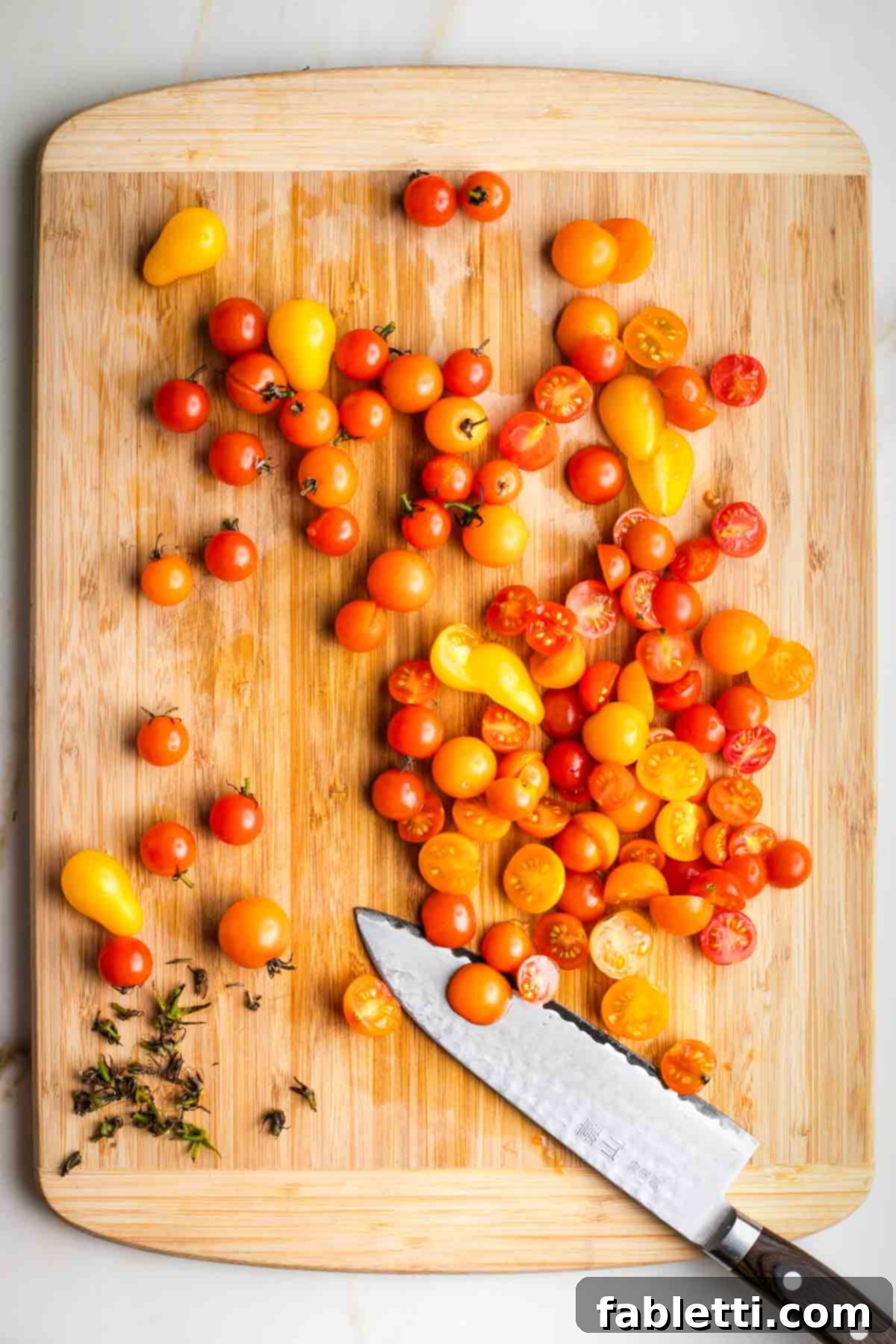
Wash your tomatoes and carefully remove their stems. For small grape or cherry tomatoes, simply halve them lengthwise. If you’re using larger tomatoes, chop them into uniform bite-sized pieces.
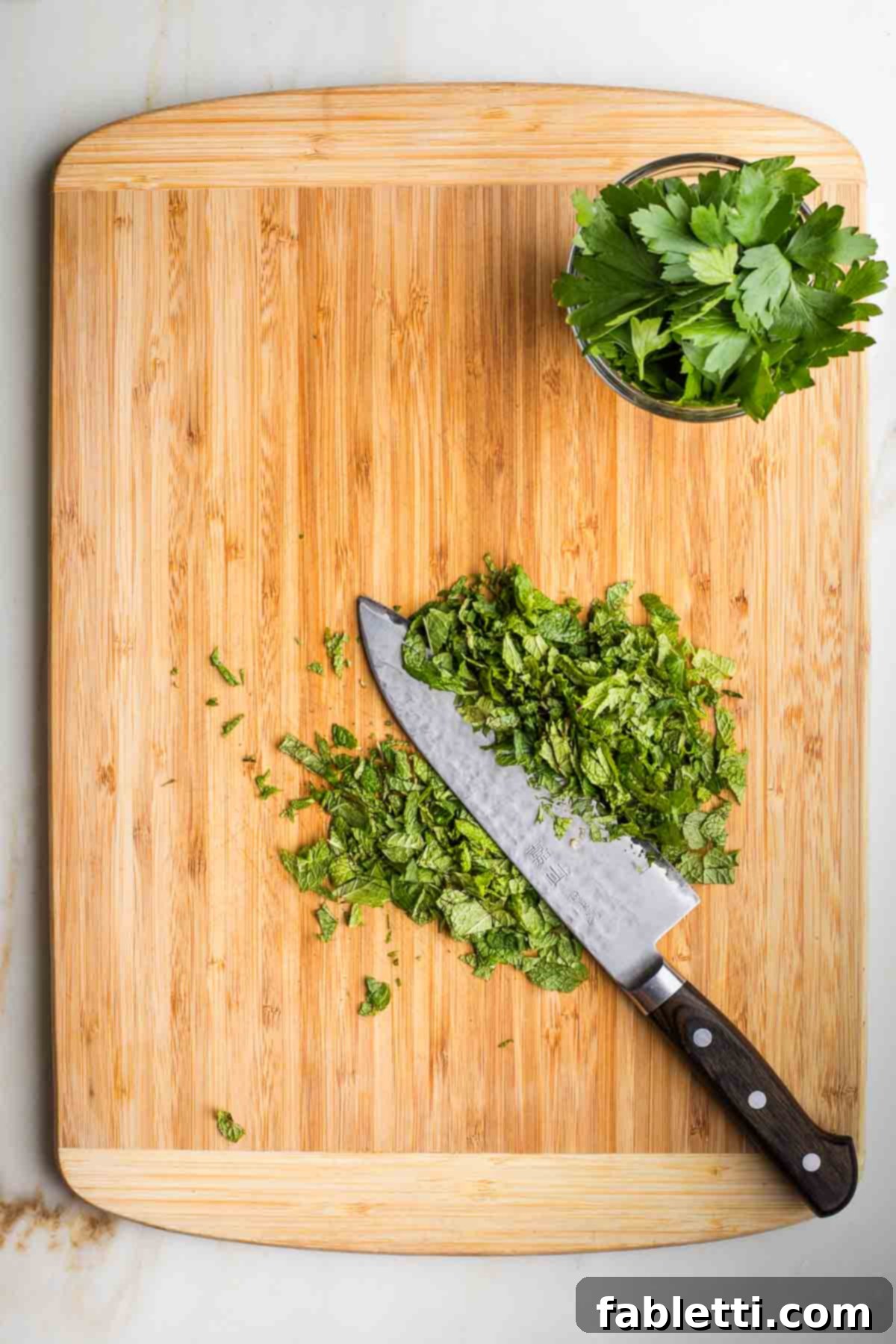
Gather your fresh herbs. Stack the mint leaves neatly and then finely chop them. Discard any tough parsley stems, then finely chop the parsley leaves as well. The finer the chop, the more evenly the flavor distributes.
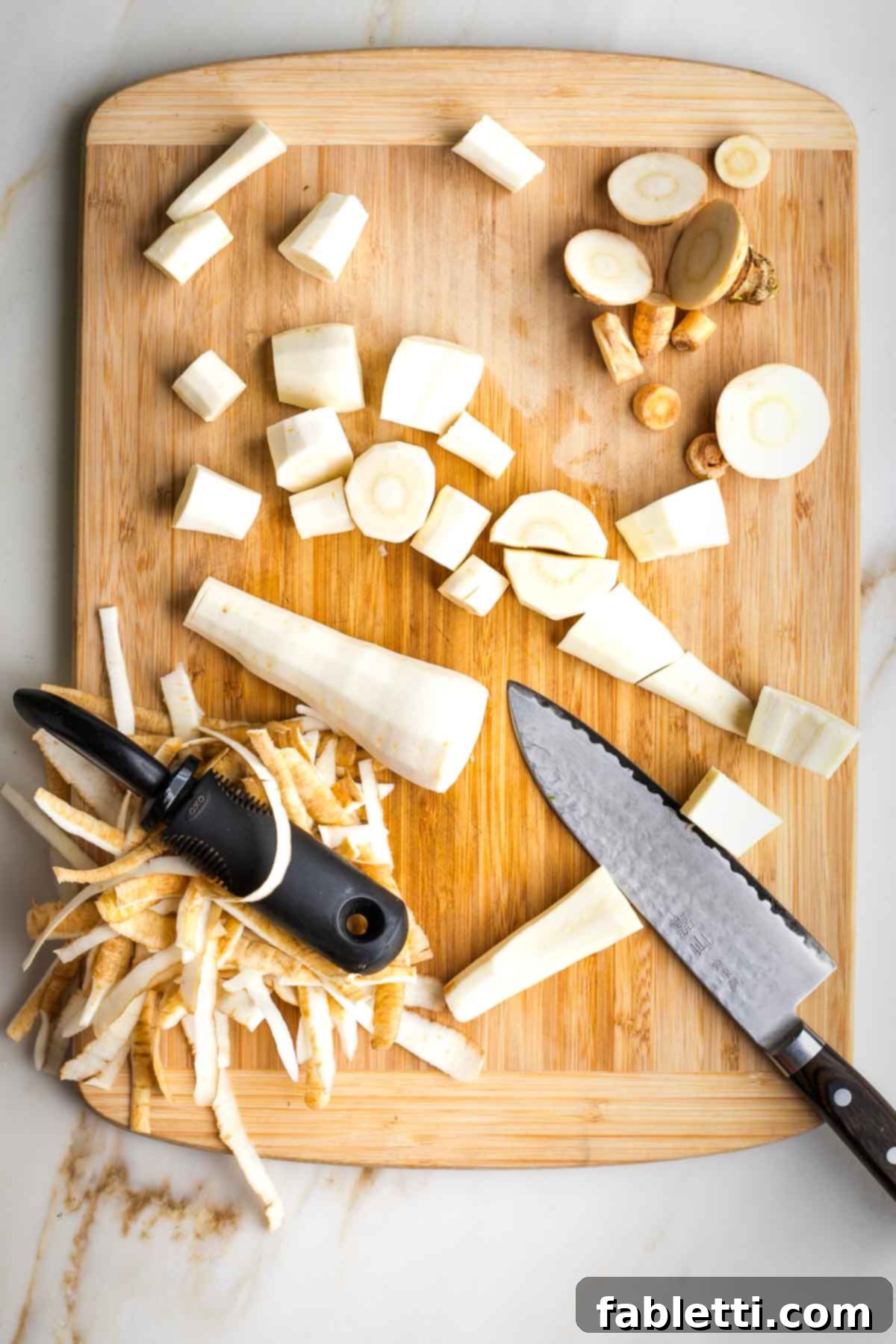
Now, for the star: the parsnips. Trim both ends, then peel them thoroughly. Cut the peeled parsnips into approximately 2-inch chunks, preparing them for the food processor.

Place the parsnip chunks into the bowl of your food processor, ensuring it’s fitted with the “S” blade. Process in pulses for best control.

Pulse the parsnips until they are finely ground and resemble the size and texture of bulgur wheat. Be careful not to over-process, or you’ll end up with a puree rather than a “rice.”

Transfer the riced parsnips to a large mixing bowl. Add all the previously prepped fresh ingredients: the chopped parsley, mint, cucumber, green onions, and tomatoes.
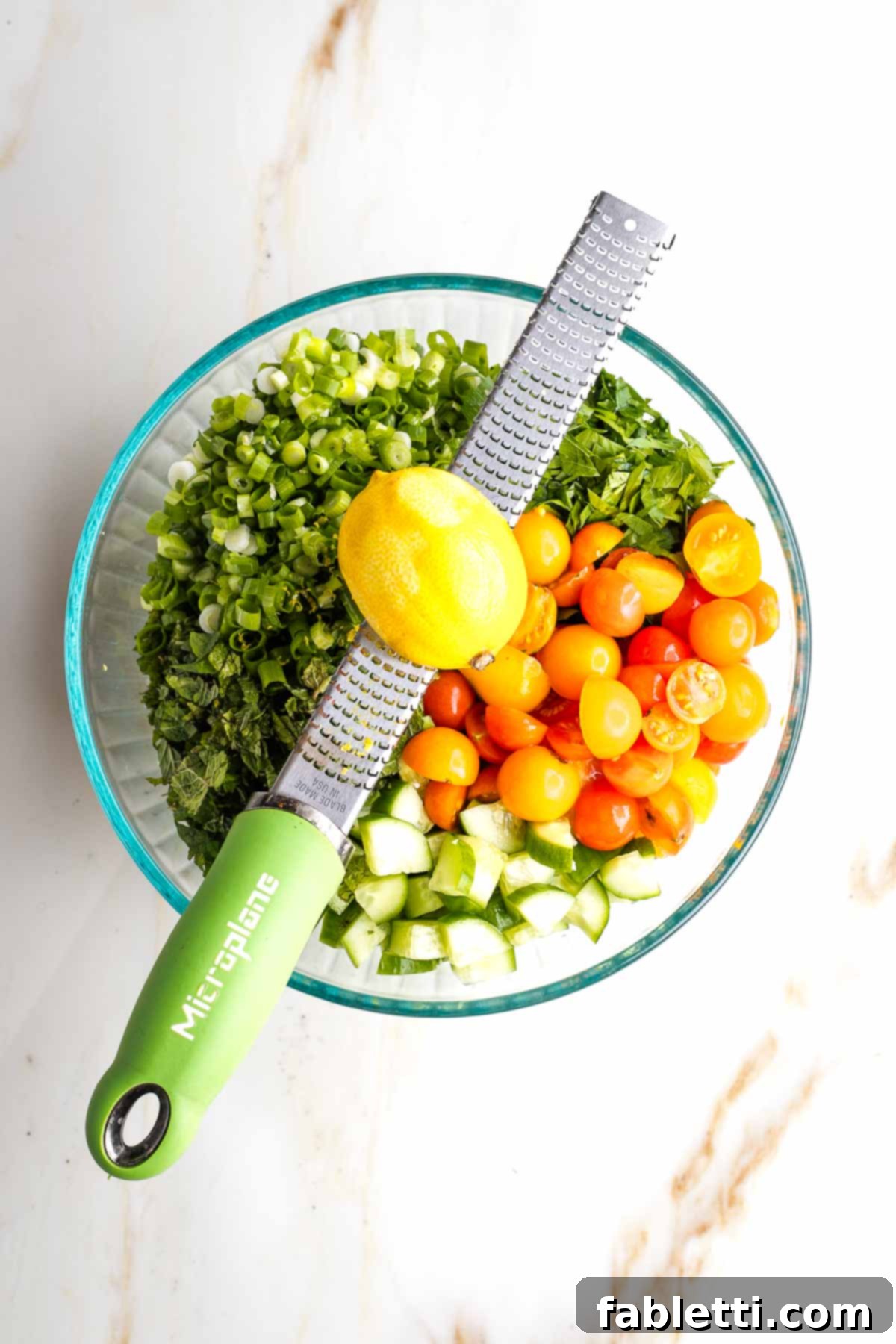
Now, it’s time to dress your salad. Zest the lemons directly over the bowl of chopped vegetables to capture all those aromatic oils. Then, squeeze the fresh lemon juice over the mixture.

Season generously with salt and freshly ground pepper. Drizzle the extra virgin olive oil over all the ingredients. These simple additions bring all the flavors to life.
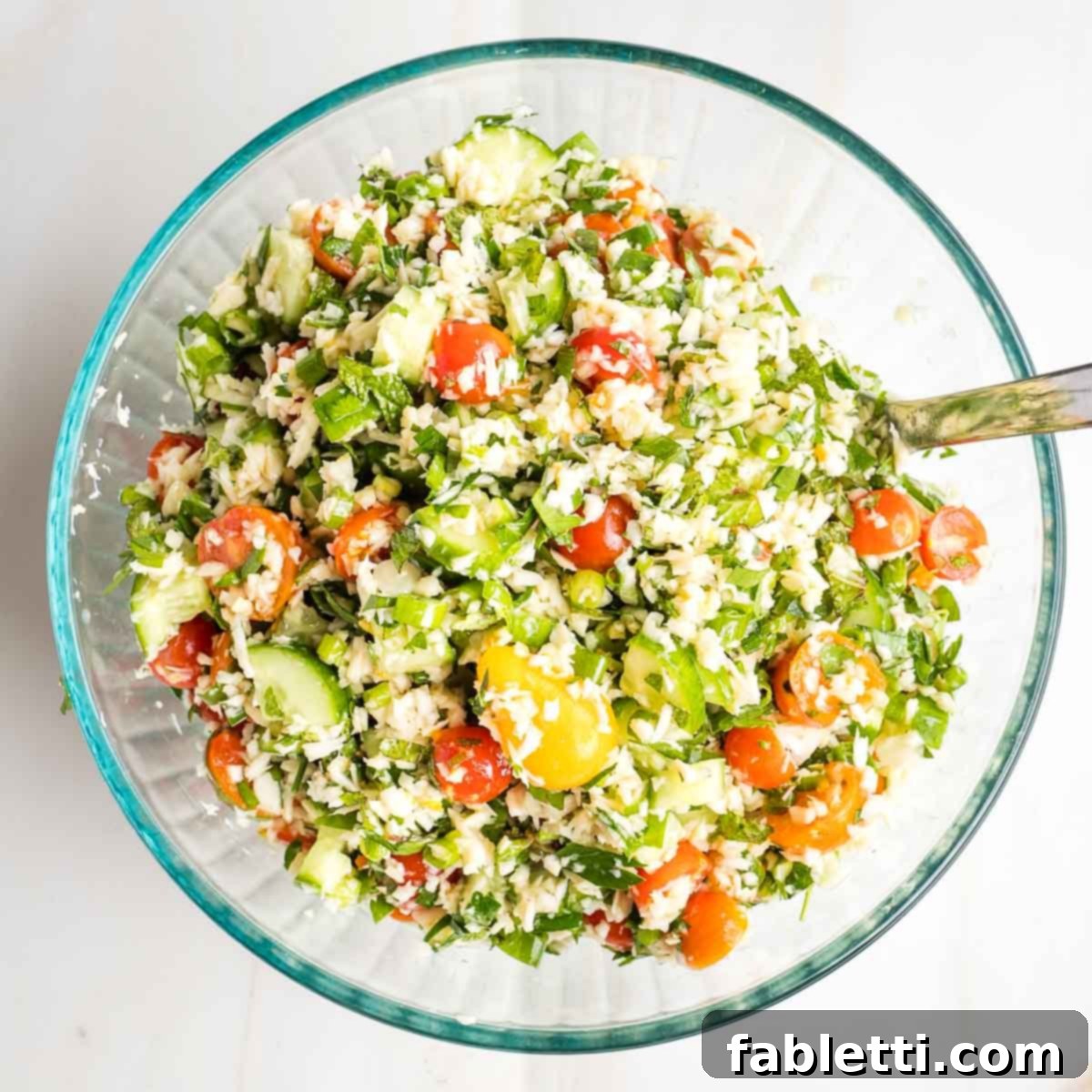
Using a large spoon or your hands, gently mix all the ingredients until everything is thoroughly combined and coated with the dressing. Taste the salad and adjust the seasoning, adding more salt, pepper, or lemon juice if desired, until it’s perfectly balanced.
Debra’s Expert Tips for Tabbouleh Perfection

- Embrace the Herbs: For truly exceptional flavor, don’t be shy with the fresh parsley. It’s the dominant herb in traditional tabbouleh and is essential for achieving that authentic, incredibly fresh taste. A generous amount makes all the difference.
- Make it a Complete Meal: While this tabbouleh shines as a side salad, it can easily be transformed into a hearty main dish. Simply toss in a can of drained and rinsed chickpeas, black beans, or a handful of sunflower or pumpkin seeds for a boost of plant-based protein and fiber, making it a perfectly balanced meal.
- Prep Ahead for Enhanced Flavor: This salad benefits greatly from a little time to marinate. Making it a few hours or even a day in advance allows the flavors to meld and intensify, resulting in an even more delicious experience.
- Serve at Room Temperature: For the best flavor and texture, allow your grain-free tabbouleh to come to room temperature before serving. This helps the vibrant flavors truly shine.
- Storage Solutions: Store any leftover tabbouleh in an airtight container in the refrigerator for up to one week. While it remains delicious, the texture might become slightly softer after 3 days. If you plan to make it several days in advance, a pro tip is to store the chopped tomatoes separately and only combine and dress them with the rest of the ingredients on the day of serving. This helps maintain their firmness and prevents the salad from becoming watery.

Serving Suggestions and Perfect Pairings
This gluten-free parsnip tabbouleh is incredibly versatile and pairs beautifully with a wide array of dishes. It makes a refreshing side for grilled chicken, fish, or plant-based proteins. For an authentic Mediterranean feast, serve it as part of a vibrant mezze platter alongside tofu shawarma, creamy baba ghanoush, light cauliflower hummus, and crispy baked falafel. Offer it with warm pita bread for dipping or crisp romaine lettuce leaves for a low-carb option. It’s also a fantastic addition to lunchboxes, potlucks, and picnics, providing a burst of fresh flavor that everyone will appreciate. Enjoy it as a light lunch on its own, or as a vibrant accompaniment to almost any meal.
Explore More Mediterranean Delights
If you’ve fallen in love with the fresh, healthful flavors of this Tabbouleh, you’ll surely enjoy exploring other Mediterranean-inspired recipes. The cuisine is renowned for its emphasis on fresh vegetables, healthy fats, and aromatic herbs, offering a wealth of delicious options for every meal.
- Mediterranean Roasted Eggplant with Tahini
- Mediterranean Cauliflower Rice
- Baba Ganoush with Roasted Garlic and Tahini
- Tomato and Onion Salad with Balsamic Dressing
Did you enjoy this recipe? Your feedback means the world! Please consider leaving a five-star rating and a comment below to support your favorite food bloggers. We’d also love to see your creations! Share your photos on Instagram by tagging me @dkhealthcoach and using the hashtag #debraklein. Your culinary adventures inspire us all!
Gluten-Free Tabbouleh Salad with Parsnips
Tabbouleh Salad without bulgur, innovatively made with riced parsnips. This easy recipe for Gluten-free Tabbouleh is light, refreshing, utterly delicious, and deeply satisfying. Perfect for a healthy side or a light meal!
Equipment
- Food Processor
- Chef’s knife
- Wooden Cutting Board
- Glass Mixing Bowls with Lids
Ingredients
- 1 lb. parsnips, riced
- 2 cups grape tomatoes*, cut in half
- 4 mini Persian cucumbers or 1 English cucumber, diced
- 1 bunch scallions, thinly sliced
- 1 cup fresh mint leaves, chopped
- 1 cup flat-leaf parsley leaves, chopped
- 2 lemons, zested and juiced
- ¼ cup extra virgin olive oil
- ½ tsp sea salt
- ½ tsp white pepper
Instructions
- Prepare Parsnips: Trim and peel the parsnips. Cut them into approximately 2-inch chunks and add them to the bowl of a food processor fitted with the “S” blade. Pulse until the parsnips are finely ground and resemble the consistency of bulgur wheat. Transfer the riced parsnips to a large mixing bowl.
- Prep Remaining Veggies: Wash and gently pat dry the tomatoes, then cut them in half (or into bite-sized pieces for larger tomatoes). Trim the ends of the cucumbers, slice them lengthwise into quarters, then cut into ½-inch pieces. Thinly slice the scallions (green onions). Add all these prepped vegetables to the large bowl with the riced parsnips.
- Chop Herbs: Stack the fresh mint leaves and parsley leaves, then finely chop them into small pieces. Add the chopped herbs to the mixing bowl with the other ingredients.
- Dress the Salad: Zest the lemons directly over the bowl of chopped veggies. Squeeze the fresh lemon juice onto the vegetables. Sprinkle the sea salt and white pepper evenly over the entire mixture, then drizzle generously with extra virgin olive oil. Mix thoroughly until all ingredients are well incorporated and coated with the dressing.
- Serve and Store: Tabbouleh is best served at room temperature to allow its flavors to fully develop. This delicious salad can be stored in an airtight container in the refrigerator for up to a week, though for optimal freshness and crunch, it’s best enjoyed within 3 days.
Notes
- Tomatoes: Feel free to use any small, ripe tomatoes such as cherry, grape, or pear. If using larger heirloom or beefsteak tomatoes, simply cut them into bite-sized pieces.
- Parsnips Substitute: If you can’t find parsnips or prefer an alternative, cauliflower rice is an excellent gluten-free substitute. Use one small head of cauliflower, cut into small florets, and pulse in a food processor until it resembles rice. Alternatively, cooked and cooled quinoa can also be used.
- Optional to make it a meal: To transform this salad into a more substantial meal, consider adding 1 can of drained and rinsed beans (like chickpeas or cannellini) and/or ½ cup of your favorite nuts or seeds (such as sunflower seeds or toasted slivered almonds) for extra protein and healthy fats.
Nutrition
Carbohydrates: 22 g
Protein: 3 g
Fat: 10 g
Saturated Fat: 1 g
Polyunsaturated Fat: 1 g
Monounsaturated Fat: 7 g
Sodium: 214 mg
Potassium: 615 mg
Fiber: 7 g
Sugar: 7 g
Vitamin A: 1662 IU
Vitamin C: 56 mg
Calcium: 83 mg
Iron: 2 mg
The nutrition calculations provided were performed using online tools and are estimates. For the most accurate representation of the nutritional information in any given recipe, it is recommended to calculate the nutritional information with the actual ingredients you used. You are ultimately responsible for ensuring that any nutritional information is accurate, complete, and useful for your dietary needs.
